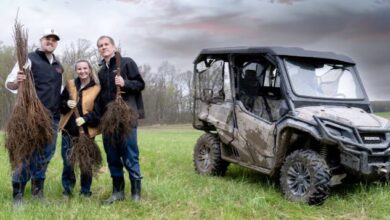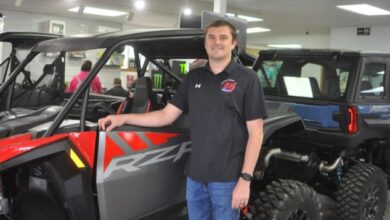Italian OEMs take spotlight at EICMA – December 4, 2006
The world’s leading motorcycle manufacturers showed a number of new products at the 64th EICMA International Milan Motorbike Show (EICMA 2006).
Major OEMs in attendance included Honda, Yamaha, Suzuki, Kawasaki, Harley-Davidson, BMW, KTM, Triumph, Polaris and BRP, yet it was the Italian firms like Piaggio, Ducati and MV Agusta that stole the show.
PIAGGIO & C. SPA
Piaggio Group CEO Roberto Colaninno, joined by Aprilia Vice President Leo Mercanti and Moto Guzzi Vice President Daniele Bandiera, unveiled several new two-wheelers under the Aprilia, Derbi, Gilera, Moto Guzzi, Piaggio and Vespa brands.
The Aprilia exhibit was highlighted by four completely new products: an automatic transmission unit called the 850 Mana, a new mid-size entry called the SL 750 Shiver, a new motocrosser dubbed the “MXV”, and a four-cylinder, 200hp engine capable of powering the brand in future MotoGP competition.
The Mana 850 is powered by a 90-degree V-twin engine delivering 75 hp at 7250 rpm and 76.5 Nm at 8000 rpm. However, the focal point of the innovative bike is without a doubt the electronically controlled seven-speed sequential transmission that allows a rider to switch from automatic mode to sequential mode at any time and in any riding condition.
In automatic mode, everything is controlled electronically. The CVT transmission enables the engine to be run at maximum torque at all times, emphasizing pick-up and acceleration. The electronic control system has three different mappings — Touring, Sport and Rain — enabling the rider to choose the type of operation most appropriate to the situation.
In Sequential mode, the rider chooses the gear by means of either the control on the handlebars or a pedal command. A servo-assisted mechanism acts mechanically on the main pulley, making changing between the seven ratios extremely rapid.
The SL 750 Shiver also contains some unique traits, including “ride by wire” electronic management of the accelerator.
The “ride-by-wire” engine management unit controls all engine parameters. All data passes through a CAN (Controlled Area Network) line to the instrument panel, which also acts as a diagnostic terminal. The CAN line uses just two wires to transmit all data. As Ducati found when installing the system, this simplifies the electrical system enormously as well as reducing the total weight of the bike.
Powered by Aprilia’s new 90-degree V2 engine producing 95hp, the 416-pound Shiver is further outfitted with a 43 mm upside down fork, lay-down shock absorber resting directly on the swingarm, and the biconical aluminium handlebars from the Tuono. Stopping power comes from braided brake lines hooked to radial-mounted calipers using the same 320 mm front disks mounted on the the RSV 1000 and Tuono 1000 R.
The third new Aprilia product shown, the MXV 450, also is the third bike in the company’s “V” range, joining the enduro RXV and supermoto SXV.
Finally, Aprilia’s new 999cc, 65-degree V4 engine produces more than 210bhp at 13.500rpm. The company says it will start testing the engine in a brand new chassis this spring, and plans on the first finished version to be at next year’s EICMA show for a 2008 attack on the World Superbike crown.
Not to be out-done by its sister company, Moto Guzzi also revealed a number of new units, including the Griso 8V, which showcases a brand new 1200cc engine sporting four valves per cylinder; the new 940 Custom; and the addition of an 850 version of the Norge tourer.
Cranking out a factory-claimed 110 horsepower and 79 lb-ft of torque, the new Griso 8V sports the familiar transverse-mounted 90-degree V-twin with a four-valve configuration for each cylinder. It also has a newly designed seat, a Brembo brake system with 320mm wave rotors.
Bandiera said the 940 Custom, shown in flat black, is likely to create “a new market segment that was previously dominated by the California models” while the Norge 850 “will help expand the ‘Gran Turismo’ offerings.”
Additional changes within the brand’s offerings include the fitment of Moto Guzzi’s reactive shaft drive system and ABS on the 750 cc Breva, Griso 850 and Griso 1100; the addition of an ABS version of the Breva 850; and new color schemes for various models.
DUCATI MOTOR HOLDING SPA
Ducati opened the 64th EICMA International Milan Motorbike Show (EICMA 2006) with a ceremony to unveil the new 1098, production Hypermotard and limited Desmosedici RR.
The platform of the event, “Winning Again,” also served to publicize the company’s new ownership structure, ongoing financial rebound and forthcoming strategic direction.
Ducati CEO Federico Minoli; Claudio Domenicali, product director; and Francesco Rapisarda, communication director, briefed the assembled crowd.
“We are pleased to be here to report that we are on the right path and winning again,” Minoli said in his opening remarks. “During the past year we obtained new ownership, cut our debts and increased equity. At the same time, we also built on our existing strengths — our brand, dealer network, marketing approach and racing activities.
“But our work is not finished. Now we shift our approach to product and fixed costs through further examination of the entire range, its design and its profitability.”
Ducati says the 1098 and 1098 S will be made available this month.
Offering 160hp and 90 lb.-ft. of torque, the 1098’s new 90-degree L-twin Testastretta Evoluzione engine, with its 104mm bore and all-new cylinder head design, is 11.1 pounds lighter than the previous superbike engine and benefits from GP6-derived elliptical throttle bodies and use of information-rich instrumentation originally developed for the new Desmosedici GP7.
Product Director Domenicali said the 1098 introduces a number of “firsts” for Ducati and production sport bike design. He said it is the first production motorcycle to have Brembo Monobloc brakes and, in the “S” version, the first to have a data acquisition system integrated as standard equipment.
Brembo’s Monobloc M4-34 calipers are machined from a single piece of alloy versus the bolt-together construction of conventional calipers — something Ducati says has much higher rigidity and resistance to distortion during extreme braking, and therefore gives a much more precise feel at the brake lever.
Standard on the “S” version, Ducati’s Data Analyser (DDA), which includes PC software, a USB-ready data retrieval card and instructions, allows performance analysis and comparisons possible. Other “S” version amenities: forged and machined wheels, carbon fiber front fender, and Ohlins front and rear suspension and steering damper.
Ducati enthusiasts will especially like the limited ‘Tricolore’ version (red, white and green), with livery celebrating the Italian style of the project by using the colors of the national flag, a gold-colored frame and a complete racing exhaust system with dedicated ECU.
Ducati says the 95hp Hypermotard 1100 will start shipping to dealers in May.
Powered by Ducati’s 1100cc Desmo engine, the 396-pound unit features a rigidly triangulated Trellis frame; 50mm Marzocchi forks, gripped by a triple screw lower fork crown; a fully adjustable Sachs shock mounted to a stout single-sided swingarm; racing-style dry clutch; Marchesini wheels; and braking via twin radially mounted Brembo four piston calipers with 305mm twin discs up front and a 245mm disc at the rear.
Need more? The Hypermotard 1100 S uses the Marzocchi 50mm forks, but with trick, low friction, Titanium Nitride (TiN) coating on the sliders, a race-spec Öhlins fully adjustable shock, Brembo Monobloc calipers; forged-aluminium wheels; and carbon fibre fork protectors, timing belt covers, rear tail section and front fender.
BIMOTA SPA
Boutique brand Bimota had five models on display: the Tesi 3D, DB5, DB5R, DB5S and DB6 Delirio.
Bimota was created in the early 1970s when co-founders Valerio Bianchi, Giuseppe Morri and Massimio Tamburini built specialized frames for racing and subsequently entered the exclusive high-performance market with bikes like the SB2 and KB1.
Tamburini left Bimota in 1983, replaced by Federico Martini, who helped lead the company through the production of nearly 15 models during the course of the next decade. Martini left in the early 1990s and was replaced by Pierluigi Marconi, who supervised the production of another 19 models.
Morri, the last remaining Bimota founder, left the company in 1993 and was replaced by Walter Martini. Under Martini, the company doubled annual production to 1,250 units in 1995.
Things began to sour during the end of the 1990s, when creation of the first all-Bimota bike, the 500 Vdue, was met by harsh riding experiences, harsher reviews, a complete recall of the bike, and a subsequent financial crisis that led to the demise of the company in 2001.
Reawakened in 2003 under new management but still headquartered in Rimini, Bimota now distributes product into the U.S. via Bimota North America, New York, New York. Bimota dealers in the U.S. include Beverly Hills Ducati, Ducati Miami, SuperMoto Italia in New York, Italian Motor Sports of San Antonio, Italian Motor Sports of Austin, Salt Lake Motorsports and Scuderia West in San Francisco.
MV AGUSTA MOTORCYCLES SPA
Also in the midst of a relaunch, the MV Agusta Group operates MV Agusta, Husqvarna and Cagiva.
Joined on-stage by Italian race legend Giacomo Agostini, MV Agusta leader Claudio Castiglioni launched EICMA by unveiling the Husqvarna STR650 CRC and a $125,000 limited edition street-legal MV Agusta.
Powered by a liquid-cooled single-cylinder four-stroke, the 291-pound STR650 appears to be a supermoto for the gentleman. While specifications have yet to be revealed, the bike carries an inverted 50mm telescopic fork, a fully adjustable rear shock, undertail exhaust, blue-anodized wheels, and Brembo brake system featuring a single 320mm disc and radial-mount four-pot caliper up front and a lone 220mm rotor in the rear.
Initially conceived by Castiglioni to offer the best of the best parts and materials, the MV Agusta F4 C.C. is powered by an all-new Euro 3-compliant 1079cc engine producing 190 hp and capable of sending the bike to 195 mph.
The limited edition C.C. — only 100 examples will be produced — also has plenty of go-fast items made of titanium, magnesium and carbon fiber, and a special brake system produced by Brembo.
MV Agusta is no stranger to limited edition units. Recent examples include the F4 Senna, Brutale Oro, F4 SPR, Brutale America, F4 Ago, Brutale Gladio, F4 Mamba, F4 Corse and F4 Tamburini.
For MV Agusta enthusiasts with a smaller bank account, the company also unveiled a new F41000R and Brutale 910R, both now Euro 3 compliant.
Founded in 1945, MV Agusta won 270 Grand Prix races — including 37 world titles — before shutting down production in 1980.
Although relaunched by Castiglioni in September 1997, the company continued to weather a number of financial upheavals resulting in bankruptcy proceedings in November 2002.
While MV Agusta kept production going thanks to a nearly $25 million loan granted to it by Italian bank Banca Intesa in early 2003, that funding didn’t last and, before long, Castiglioni was again searching for a funding package to keep the company afloat.
In June 2004, Malaysian auto manufacturer Perusahaan Otomobil Nasional Bhd (Proton) received a 57.8 percent share of MV Agusta for underwriting a Euro 70 million ($83 million) loan from CitiBank. The Proton deal allowed MV Agusta to meet all of its outstanding debts with banks and suppliers, and terminated the bankruptcy proceedings started two years earlier.
In 2005, the company built 34,000 MV Agusta, Cagiva and Husqvarna brand motorcycles.
Financial certainty for MV Agusta didn’t last long, however. In December 2005, Proton announced a controversial plan to sell its 57.8 percent stake to Italian investment company Gevi SpA for one Euro ($1.19).
Proton says the decision for the sale was made because of a $3.3 million first quarter net loss, a $40.8 million second quarter net loss, and continued debt stemming from the motorcycle brand. Gevi made the purchase for one Euro, assumed Euro 107 million in outstanding debt and took responsibility for Euro 32.5 million ($38.5 million) in capital requirements.
Now owned by Gevi (57.75 percent), Castiglioni (37.25 percent), Electrolux (3 percent) and Massimo Tamburini (2 percent), MV Agusta distributes its motorcycles in the United States via Cagiva USA, Willow Grove, Penn., and 32 dealerships.




